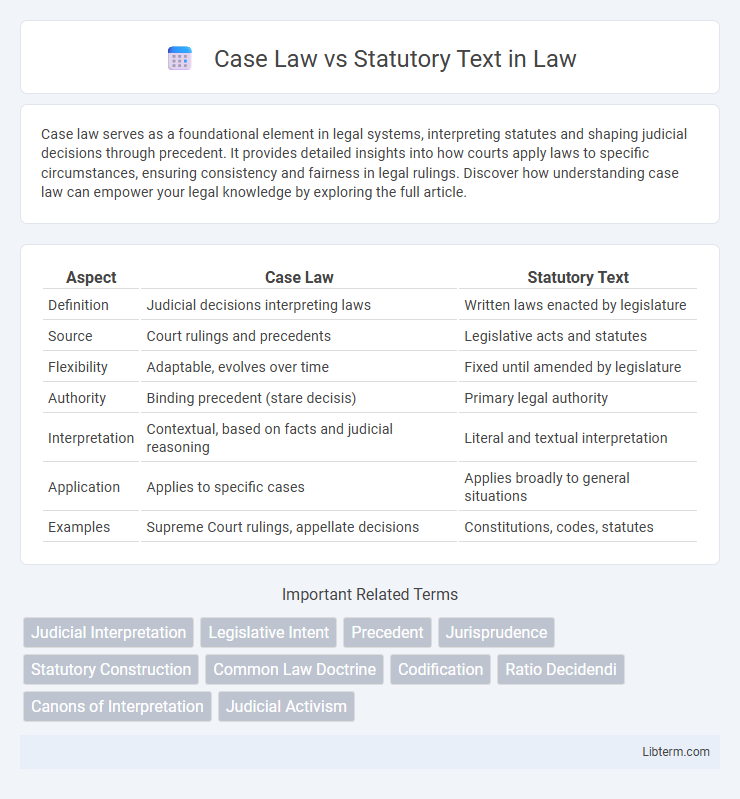Case law serves as a foundational element in legal systems, interpreting statutes and shaping judicial decisions through precedent. It provides detailed insights into how courts apply laws to specific circumstances, ensuring consistency and fairness in legal rulings. Discover how understanding case law can empower your legal knowledge by exploring the full article.
Table of Comparison
| Aspect | Case Law | Statutory Text |
|---|---|---|
| Definition | Judicial decisions interpreting laws | Written laws enacted by legislature |
| Source | Court rulings and precedents | Legislative acts and statutes |
| Flexibility | Adaptable, evolves over time | Fixed until amended by legislature |
| Authority | Binding precedent (stare decisis) | Primary legal authority |
| Interpretation | Contextual, based on facts and judicial reasoning | Literal and textual interpretation |
| Application | Applies to specific cases | Applies broadly to general situations |
| Examples | Supreme Court rulings, appellate decisions | Constitutions, codes, statutes |
Introduction to Case Law and Statutory Text
Case law consists of judicial opinions and interpretations that establish legal precedents guiding future court decisions, reflecting how laws are applied in specific circumstances. Statutory text refers to the laws formally enacted by legislative bodies, providing the foundational legal rules and frameworks. Understanding the interplay between case law and statutory text is crucial for interpreting legal obligations and rights effectively.
Defining Case Law: Origin and Evolution
Case law originates from judicial decisions interpreting statutes and constitutional provisions, evolving through precedent established by higher courts. This body of law develops dynamically as courts resolve new legal issues, ensuring adaptability within the legal system. Key sources include appellate court rulings and Supreme Court opinions, which shape legal principles beyond explicit statutory text.
Understanding Statutory Text: Creation and Authority
Statutory text is created through the legislative process, where elected bodies draft, debate, and enact laws that provide clear, codified rules governing behavior and rights. Its authority stems from the formal legitimacy of statutes, which courts interpret to resolve disputes, often relying on plain language, legislative intent, and legal principles. Understanding statutory text involves analyzing the precise wording and structure to discern legislative purpose and ensure consistent application across cases.
Key Differences Between Case Law and Statutory Text
Case law arises from judicial decisions and interpretations, shaping legal principles through precedents, whereas statutory text consists of laws formally enacted by legislative bodies. Case law adapts to specific circumstances and evolves over time, providing nuanced applications of the law, while statutory text offers clear, codified rules intended to guide uniform legal standards. The key difference lies in case law's reliance on past judgments versus statutory law's foundation in written, enacted statutes.
The Role of Courts in Interpreting Statutes
Courts play a crucial role in interpreting statutes by applying case law principles to resolve ambiguities and gaps within statutory text. Judicial interpretation ensures statutes are consistently applied, adapting legal rules to complex, real-world scenarios through precedent established in prior decisions. This dynamic interplay between case law and statutory text shapes the evolving understanding and enforcement of legislation.
Precedent and Its Impact on Legal Interpretation
Precedent, established through case law, plays a critical role in legal interpretation by guiding courts to apply consistent principles derived from prior judicial decisions. Unlike statutory text, which provides explicitly written laws enacted by legislatures, precedent allows for the adaptation of legal reasoning to evolving societal contexts. This dynamic interplay ensures stability in the legal system while accommodating nuanced interpretations aligned with contemporary issues.
The Legislative Process: How Statutes Become Law
The legislative process transforms proposed bills into statutes through multiple stages including drafting, committee review, floor debate, and voting in both legislative chambers, followed by executive approval or veto. Statutory text represents formal legal rules enacted by legislatures, providing clear, written authority intended for broad application and consistency. Case law, by contrast, evolves through judicial interpretation and application of these statutes, resolving ambiguities and adapting legal principles to specific circumstances over time.
Conflicts Between Case Law and Statutory Text
Conflicts between case law and statutory text arise when judicial interpretations diverge from the original legislative intent or the explicit language of statutes. Courts may apply principles such as the plain meaning rule or legislative history to resolve discrepancies, yet inconsistent rulings can create legal uncertainty. Understanding the dynamic interplay between statutory mandates and judicial precedent is essential for accurate legal analysis and effective advocacy.
Practical Implications for Legal Practitioners
Legal practitioners must navigate the dynamic interaction between case law and statutory text to effectively interpret and apply laws in real-world scenarios. Case law provides interpretative guidance and precedent essential for understanding statutory provisions where language may be ambiguous or outdated. Mastery of both statutory frameworks and relevant judicial decisions ensures accurate legal advice, strategic litigation, and adaptability to evolving legal standards.
Conclusion: Harmonizing Case Law and Statutory Interpretation
Harmonizing case law and statutory interpretation ensures consistent application of legal principles by aligning judicial precedents with the explicit language of statutes. This approach enhances legal predictability and respects legislative intent, fostering a coherent and adaptable legal framework. Effective integration of case law complements statutory text by addressing ambiguities and evolving societal contexts without undermining codified laws.
Case Law Infographic

 libterm.com
libterm.com